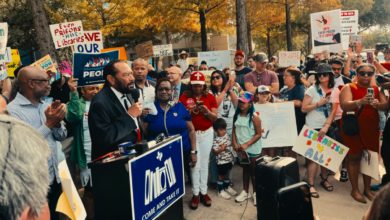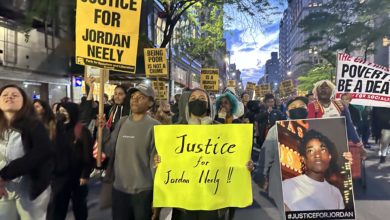The nomination of Sonia Sotomayor for the U.S. Supreme Court has become a pretext for a new volley of right-wing rhetoric against affirmative action.
|
Recognizing the opportunity, right-wing commentators swooped down on Ricci v. DeStefano like hawks to launch a renewed offensive against affirmative action—one that is full of distortions and entirely deprived of historical context.
Racial preference in the United States was around long before affirmative action. In fact, racial preference has been in existence in the United States since its inception. Because whites alone were allowed to own property and attend elite schools, they were granted profoundly unfair advantages in both the workplace and in education. Much of the racism once explicitly protected by law still persists through institutionalized practices. The resulting legacy of poverty and disenfranchisement continues to marginalize Black people.
In other words, affirmative action does not grant preferences for women and people of color, but rather attempts to overcome the unjust preferences historically enjoyed by white people—particularly white males. It is an effort to institutionalize justice for marginalized communities—including African Americans, Latinos, women, and the disabled—in the workplace and schools.
In a 2007 debate on the relevance of affirmative action, anti-racist author Tim Wise noted, “[T]he entire history of this country is the history of affirmative action for white folks […] enslavement, Indian genocide, and segregation not only oppressed people of color, but elevated whites and provided us with opportunities we did not earn.”
These “unearned opportunities” include the dispossession of Native people and the enslavement of African Americans, who were considered only three-fifths of a person. White merchants built their local economies largely around supplying ships for the trade in slaves and the goods that slaves produced: sugar, tobacco, indigo, coffee, chocolate and cotton.
Another unearned opportunity that benefited whites in the early history of this country were the Homestead Acts, which gave grants to whites to settle in newly conquered Native American land. After having tended the land for five years, these settlers were given ownership rights. Meanwhile, non-whites were not considered citizens and were not allowed to attend school, vote or own property.
The roots of affirmative action in the United States
Affirmative action has its early roots in the struggle to address these fundamental inequalities, in the policies adopted during the post-Civil War Reconstruction period, including the passage of the 13th, 14th and 15th constitutional amendments. The Equal Protection Clause of the 14th Amendment required that states provide all citizens equal protection of the law regardless of race, and became the foundation of many battles for civil rights in the 20th century.
Reconstruction, a federal plan meant to suppress the former slavocracy and redress oppressive conditions for Black people in the South, was the most progressive period of U.S. history. As one measure of the progress, in the period of 1870 to 1876, there were 633 African American state legislators in 11 Southern states, and 15 U.S. Congress members.
But Reconstruction was short-lived, and the Northern ruling class soon dismantled the plan and allowed racist terror to reign once again. Reconstruction lasted from 1865 to 1877. The Southern states reinstituted “Black codes” to force a system of peonage on Black people, and to deny them access to most employment and education opportunities. They restricted civil liberties and acted to assure that African Americans would remain disenfranchised. Jim Crow segregation became the law of the land in the South.
It is important to understand how institutionalized racism—in the North as well as the South—and deliberate denial of employment, educational and political rights for Black people throughout the history of the United States created an overwhelming advantage for white people in society. Yet those who reap the real rewards are the capitalists, who exploit all workers and keep the working class divided.
When racism wins, all workers lose
The struggle against racism is not only a race issue; it is very much a class issue. All workers—Black or white—stand to lose from racist divisions sown by the capitalist class.
The divisive wedge of racism has all too often been used to weaken labor’s ability to organize. These divisions stunt the development of the necessary unity among workers for waging the most effective struggle against the exploitation of the bosses.
It is no coincidence the Southern states, where the historic legacy of racism weighs heaviest, pose some of the greatest challenges for labor. Workers of all races receive relatively lower wages in the South, where anti-union laws are prevalent.
Among these legal obstacles are “right-to-work” laws, which do not allow union contracts to require workers to join the union. Those laws often prohibit the union from collecting dues from non-members even when non-members enjoy the benefits won through collective bargaining, further eroding the union’s resources.
Courts roll back progressive gains
Affirmative action in its modern form was born in the struggle of the 1960s, in the midst of the ongoing Civil Rights Movement. It was followed by a series of executive orders prohibiting discriminatory hiring practices based on race, creed, color or national origin.
However, affirmative action suffered a major setback in 1978 with the Supreme Court ruling in Regents of the University of California v. Bakke, known as the Bakke decision.
In the late 1960s, student struggles had forced schools to open the doors and admit more students of color. Among the gains was a quota system to assure that the schools would admit Black, Latino and other students. This was achieved by the administrations taking race into consideration to assure a diverse student population.
At the height of this struggle, in 1968, Black and Latino students at San Francisco State University, Stanford University, Brandeis University, Cornell and many other campuses raised radical demands that their communities must have greater access to education in order to reverse years of racist exclusion by the administrations. Poverty, huge deficiencies in primary education for youth of color, and deliberate racist exclusionary policies of the schools had created almost all-white student bodies. The use of race as a factor in admissions became an accepted practice to increase the abysmally low percentage of students of color.
Bakke was the first blow to that progress. That ruling banned the principal use of race as a factor. In 1995, California’s Proposition 209 prohibited the consideration of race, gender or ethnicity by public institutions. In 1996, Hopwood v. University of Texas Law School completely banned the use of race within the 5th Circuit Court of Appeals district of Louisiana, Texas and Mississippi.
With the election of Barack Obama, many hoped that a government founded by slaveholders, developed on the backs of chattel slaves and expanded through violent conquest would begin to come to terms with its horrific legacy. However, a “post-racial” United States remains a dangerous myth. Schools are more segregated today than they were in the 1970s, and unemployment among African American workers is far higher than the national average. Recent studies have shown that candidates with “white-sounding names” have a 50 percent greater chance of getting called back for a job interview even when qualifications are indistinguishable.
Affirmative action is still urgently needed to address both historic and continuing inequalities within U.S. society. Legal challenges to it are a manifestation of deeply reactionary values held by those who benefit most directly from those very inequalities. Progressive people must stand together in strong defense of affirmative action wherever and whenever it falls under attack.







